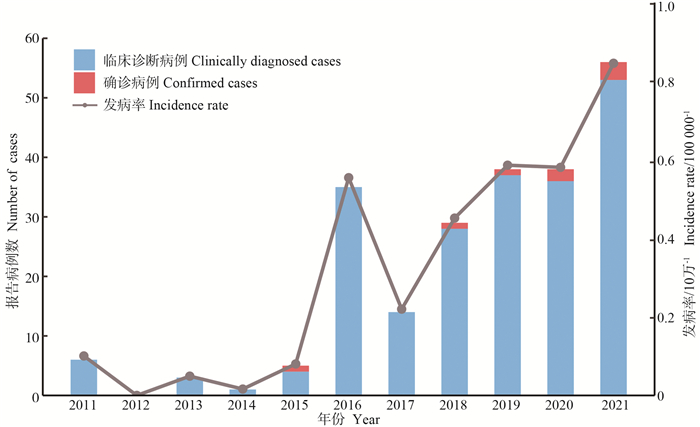Epidemiological characteristics and spatial-temporal clusters of scrub typhus in Taizhou City from 2011 to 2021
ZHANG Zhiyi and HU Yafei contributed equally to this article
More Information
-
摘要:
目的 了解台州市2011―2021年恙虫病的流行特征与时空聚集性,为台州市恙虫病的预防与控制提供科学依据。 方法 从台州市疾病预防控制中心获得台州市2011―2021年恙虫病病例的资料,使用SaTScan 9.6软件进行时空聚集性分析和结果可视化。 结果 2011―2021年台州市共报告恙虫病病例225例,年均发病率为0.32/10万。以50~69岁人群为主,占65.8%(148/225)。职业分布以农民为主,占87.1%(196/225)。仙居县位于台州市西北部,以低山地貌为主,为该病高发地区,报告病例数占比53.3%(120/225),该地区是扫描出的一类聚集区;二类聚集区为天台县、三门县和临海市交界地区。 结论 台州市2011―2021年恙虫病发病率呈上升趋势,易感人群主要为山区≥50岁中老年农民,应加强对易感人群的宣传教育工作,在野外劳作时做好个人防护,控制恙虫病的发生和流行。 Abstract:Objective To analyze the epidemiological characteristics and spatial-temporal clusters of scrub typhus in Taizhou during 2011-2021, and provide scientific evidence on prevention and control for scrub typhus. Methods Information on scrub typhus cases in Taizhou from 2011 to 2021 was obtained from Taizhou Center for Disease Control and Prevention. Spatial-temporal clusters analysis and result visualization were performed using SaTScan 9.6 software. Results A total of 225 cases of scrub typhus were reported from 2011 to 2021 in Taizhou, with an average annual incidence of 0.32/100 000. The primary affected demographic was individuals aged 50-69 years, which constituted 65.78% (148/225) of the cases. Farmer was the primary occupation and accounted for 87.11% (196/225). Xianju County is located in the northwest of Taizhou City, mainly with low mountainous landforms, which emerged as a high-incidence area with 53.33% (120/225) reported cases. This area is also the first cluster area. And the second cluster area was the junction area of Tiantai County, Sanmen County and Linhai City. Conclusions The incidence of scrub typhus in Taizhou from 2011 to 2021 was showing an upward trend. The susceptible people are mainly middle-aged and elderly farmers in mountainous areas. It is necessary to strengthen the publicity and education for these people, and personal protection should be done when working in the field to control the occurrence and prevalence of scrub typhus. -
表 1 台州市2011―2021年恙虫病时空聚集性分析
Table 1. Spatial- temporal cluster of scrub typhus in Taizhou, 2011-2021
类型Types 实际病例数
Actual number of cases理论病例数
Theoretical number of cases半径/km
Radius/km聚集时间
(年/月/日)
Clusters time
(Year/Month/Date)涉及乡镇/街道
Involved town/StreetsRR值
valueLLR值
valueP值
value一类聚集区
First cluster area57 7.90 37.33 2019/5/1―2021/10/31 仙居县(淡竹乡、皤滩乡、南峰街道、安洲街道、横溪镇、埠头镇、白塔镇、田市镇、官路镇、朱溪镇、安岭乡、溪港乡、上张乡、步路乡、大战乡、湫山乡、双庙乡),黄岩区(上郑乡、富山乡、宁溪镇)
Xianju County (Danzhu Township, Potan Township, Nanfeng Street, Anzhou Street, Hengxi Town, Butou Town, Baita Town, Tianshi Town, Guanlu Town, Zhuxi Town, An′ling Township, Xigang Township, Shangzhang Township, Bulu Township, Dazhan Township, Qiushan Township, Shuangmiao Township), Huangyan District (Shangzheng Township, Fushan Township, Ningxi Town)9.53 70.08 < 0.001 二类聚集区
Second cluster area34 14.46 40.71 2019/4/1―2021/10/31 三门县(海游街道、健跳镇、海润街道、沙柳街道、珠岙镇、亭旁镇、横渡镇、浦坝港镇、花桥镇、蛇蟠乡),天台县(泳溪乡、洪畴镇、赤城街道、福溪街道、石梁镇、坦头镇、三合镇),临海市(涌泉镇、桃渚镇、大洋街道、大田街道、邵家渡街道、东塍镇、汇溪镇、小芝镇、河头镇)
Sanmen County (Haiyou Street, Jiantiao Town, Hairun Street, Shaliu Street, Zhu ′ao Town, Tingpang Town, Hengdu Town, Pubagang Town, Huaqiao Town, Shepan Township), Tiantai County (Yongxi Township, Hongchou Town, Chicheng Street, Fuxi Street, Shiliang Town, Tantou Town, Sanhe Town), Linhai City (Yongquan Town, Taozhu Town, Dayang Street, Datian Street, Shaojiadu Street, Dongcheng Town, Huixi Town, Xiaozhi Town, Hetou Town)2.61 10.53 0.010 -
[1] Indrawattana N, Aiumurai P, Sae-Lim N, et al. GroEL chaperonin-based assay for early diagnosis of scrub typhus[J]. Diagnostics, 2022, 12(1): 136. DOI: 10.3390/diagnostics12010136. [2] Fisher J, Card G, Soong L. Neuroinflammation associated with scrub typhus and spotted fever group rickettsioses[J]. PLoS Negl Trop Dis, 2020, 14(10): e0008675. DOI: 10.1371/journal.pntd.0008675. [3] Xu G, Walker DH, Jupiter D, et al. A review of the global epidemiology of scrub typhus[J]. PLoS Negl Trop Dis, 2017, 11(11): e0006062. DOI: 10.1371/journal.pntd.0006062. [4] Lu CT, Wang LS, Hsueh PR. Scrub typhus and antibiotic-resistant Orientia tsutsugamushi[J]. Expert Rev Anti Infect Ther, 2021, 19(12): 1519-1527. DOI: 10.1080/14787210.2021.1941869. [5] 李文, 李贵昌, 刘小波, 等. 恙虫病流行特征及影响因素研究进展[J]. 中国媒介生物学及控制杂志, 2020, 31(6): 738-743. DOI: 10.11853/j.issn.1003.8280.2020.06.025.Li W, Li GC, Liu XB, et al. Research progress in epidemiological characteristics and influencing factors of scrub typhus[J]. Chin J Vector Biol Control, 2020, 31(6): 738-743. DOI: 10.11853/j.issn.1003.8280.2020.06.025. [6] Zhang WY, Wang LY, Ding F, et al. Scrub typhus in mainland China, 2006-2012: the need for targeted public health interventions[J]. PLoS Negl Trop Dis, 2013, 7(12): e2493. DOI: 10.1371/journal.pntd.0002493. [7] 吕燕宁, 别楚皞, 窦相峰, 等. 2009―2019年北京市恙虫病流行特征分析[J]. 中国人兽共患病学报, 2021, 37(3): 236-240. DOI: 10.3969/j.issn.1002-2694.2021.00.028.Lyu YN, Bie CH, Dou XF, et al. Epidemiological characteristics of scrub typhus in Beijing during 2009-2019[J]. Chinese Journal of Zoonoses, 2021, 37(3): 236-240. DOI: 10.3969/j.issn.1002-2694.2021.00.028. [8] 上官致洋, 吴斐琳, 严秀英, 等. 2011-2015年抚州市恙虫病流行特征分析[J]. 中华疾病控制杂志, 2018, 22(2): 153-156. DOI: 10.16462/j.cnki.zhjbkz.2018.02.012.Shangguan ZY, Wu FL, Yan XY, et al. Analysis on the epidemiological characteristics of scrub typhus in Fuzhou from 2011 to 2015[J]. Chin J Dis Control Prev, 2018, 22(2): 153-156. DOI: 10.16462/j.cnki.zhjbkz.2018.02.012. [9] 张育富, 刘大鹏, 褚宏亮. 江苏省2008-2017年恙虫病流行特征和时空聚集性分析[J]. 中国媒介生物学及控制杂志, 2019, 30(3): 237-243. DOI: 10.11853/j.issn.1003.8280.2019.03.002.Zhang YF, Liu DP, Chu HL. An analysis of epidemiological characteristics and spatiotemporal clustering of scrub typhus in Jiangsu province, China, during 2008-2017[J]. Chin J Vector Biol Control, 2019, 30(3): 237-243. DOI: 10.11853/j.issn.1003.8280.2019.03.002. [10] 朱梦, 姚慧媛, 宋丹丹, 等. 安徽省2008-2017年恙虫病流行特征与重复感染分析[J]. 中华疾病控制杂志, 2019, 23(2): 191-195. DOI: 10.16462/j.cnki.zhjbkz.2019.02.014.Zhu M, Yao HY, Song DD, et al. Epidemiological characteristics and repeated infection analysis of scrub typhus in Anhui Province from 2008 to 2017[J]. Chin J Dis Control Prev, 2019, 23(2): 191-195. DOI: 10.16462/j.cnki.zhjbkz.2019.02.014. -





 下载:
下载:


